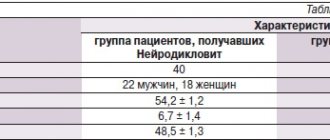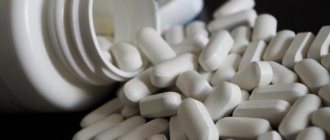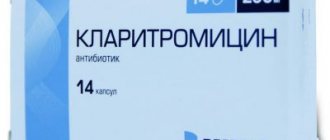Sirdalud MP, 6 mg, modified-release capsules, 30 pcs.
Pharmaceutical group: centrally acting muscle relaxant. Pharmaceutical action: Tizanidine is a centrally acting muscle relaxant. The main point of application of its action is in the spinal cord. By stimulating presynaptic α2 receptors in the spinal cord, tizanidine inhibits the release of excitatory amino acids that stimulate NMDA receptors. As a result, polysynaptic transmission of excitation is suppressed at the level of interneurons of the spinal cord. Since it is this mechanism that is responsible for excess muscle tone, when it is suppressed, muscle tone decreases. In addition to its muscle relaxant properties, tizanidine also has a moderate central analgesic effect. Sirdalud® is effective both for acute painful muscle spasms and for chronic spasticity of spinal and cerebral origin. Reduces spasticity and clonic convulsions, as a result of which resistance to passive movements decreases and the range of active movements increases. The muscle relaxant effect (measured on the Ashworth scale and using the “pendulum” test) and side effects (decrease in heart rate and blood pressure) of Sirdalud® depend on the concentration of the drug in the blood plasma. Pharmacokinetics: Absorption Tizanidine is absorbed quickly and almost completely. Cmax in plasma is achieved approximately 1 hour after taking the drug. Due to the pronounced first-pass metabolism through the liver, the average bioavailability is about 34%. Cmax of tizanidine is 12.3 ng/ml and 15.6 ng/ml after single and multiple doses of tizanidine 4 mg, respectively. Concomitant food intake does not affect the pharmacokinetics of tizanidine. Although the Cmax value increases by 1/3 when the tablet is taken after a meal, this is not considered to be clinically significant. There is no significant effect on absorption (AUC). Tizanidine in the dose range from 1 mg to 20 mg has linear pharmacokinetics. Distribution Plasma protein binding is 30%. Metabolism Tizanidine is rapidly and extensively (about 95%) metabolized in the liver. In vitro, tizanidine has been shown to be primarily metabolized by cytochrome P450 isoenzyme 1A2. Metabolites are inactive. Excretion The average half-life of tizanidine from the systemic circulation is 2-4 hours. The drug is excreted primarily by the kidneys (approximately 70% of the dose) in the form of metabolites; the share of unchanged substance accounts for only about 4.5%. Pharmacokinetics in special clinical situations In patients with renal failure (creatinine clearance ≤ 25 ml/min), the average Cmax of the drug in plasma is 2 times higher than in healthy volunteers, and the final T1/2 reaches 14 hours, which leads to an increased (approximately 6 times) systemic bioavailability of tizanidine (measured by AUC)/ No specific studies have been conducted in patients with impaired liver function. Tizanidine is predominantly metabolized in the liver by cytochrome CYP1A2, therefore, impaired liver function may lead to increased systemic exposure of the drug. Pharmacokinetic data in patients over 65 years of age are limited. Gender does not affect the pharmacokinetic properties of tizanidine. The influence of ethnicity and race on the pharmacokinetics of tizanidine has not been studied.
Side effects
Adverse reactions - such as drowsiness, fatigue, dizziness, dry mouth, decreased blood pressure, nausea, gastrointestinal disorders and increased levels of transaminases in the blood plasma - are usually mild and transient in patients using the drug in low doses, recommended for relief painful muscle spasm.
When taken in higher doses than recommended for spasticity, the above adverse reactions occur more frequently and are more severe, but they are rarely severe enough to warrant discontinuation of treatment. The following adverse reactions may also occur: hypotension, bradycardia, muscle weakness, sleep disturbance, hallucinations and hepatitis.
The appearance of such symptoms has been reported after sudden discontinuation of tizanidine, especially after long-term treatment and/or use in high daily doses and/or concomitant therapy with antihypertensive drugs. Under such circumstances, patients may experience hypertension and tachycardia. In some cases, such rebound hypertension can cause a stroke. Therefore, treatment with tizanidine should not be stopped suddenly, but only by gradually reducing the dose.
To assess the incidence of various adverse reactions, the following classification was used: very often (≥1/10), often (≥1/100, 1/10), uncommon (≥1/1000, 1/100), rarely (≥1/10 000, 1/1000), very rarely (1/10,000), including individual messages.
Mental disorders: often - insomnia, sleep disturbance.
From the side of the central nervous system: very often - drowsiness, dizziness; frequency unknown - confusion, vertigo.
From the heart: infrequently - bradycardia
From the vascular system: often - arterial hypotension; slight decrease in blood pressure.
From the digestive tract: very often - dry mouth, gastrointestinal disorders; often - nausea.
Hepatobiliary disorders: often - increased levels of transaminases in the blood plasma.
From the musculoskeletal system: very often - muscle weakness.
General disorders: very often - increased fatigue.
Post-marketing studies
Additional adverse reactions to the drug were reported in post-marketing studies.
These adverse reactions have been reported from an unknown number of patients, so their frequency cannot be reliably estimated.
From the immune system: hypersensitivity reactions (including anaphylaxis, swelling of the throat, shortness of breath and urticaria).
Mental disorders: hallucinations, confusion.
From the side of the central nervous system: vertigo.
From the cardiovascular system: syncope.
From the side of the organ of vision: blurred vision.
Hepatobiliary disorders: hepatitis, liver failure.
From the skin and subcutaneous tissue: rash, erythema, itching, dermatitis.
General disorders: asthenia, withdrawal syndrome.
Note!
Description of the drug Sirdalud table. 4mg No. 30 on this page is a simplified author’s version of the apteka911 website, created on the basis of the instructions for use.
Before purchasing or using the drug, you should consult your doctor and read the manufacturer's original instructions (attached to each package of the drug). Information about the drug is provided for informational purposes only and should not be used as a guide to self-medication. Only a doctor can decide to prescribe the drug, as well as determine the dose and methods of its use.
Interactions
Concomitant use of known cyp 1a2 inhibitors may increase plasma levels of tizanidine. An increase in tizanidine plasma levels may lead to symptoms of overdose, such as prolongation of the qt interval.
Concomitant use of known CYP1A2 inducers may reduce plasma levels of tizanidine. A decrease in the plasma level of tizanidine may lead to a decrease in the therapeutic effect of Sirdalud.
Concomitant use of strong CYP1A2 inhibitors such as fluvoxamine or ciprofloxacin with tizanidine is contraindicated. Coadministration of tizanidine with fluvoxamine increased tizanidine AUC by 33-fold, while coadministration of tizanidine with ciprofloxacin increased tizanidine AUC by 10-fold. This can lead to a clinically significant and long-lasting decrease in blood pressure, accompanied by drowsiness, dizziness, and decreased psychomotor performance.
Concomitant use of tizanidine with other CYP1A2 inhibitors such as antiarrhythmic drugs (amiodarone, mexiletine, propafenone), cimetidine, some fluoroquinolones (enoxacin, pefloxacin, norfloxacin), rofecoxib, oral contraceptives and ticlopidine is not recommended.
Elevated plasma levels of tizanidine may cause overdose symptoms, including prolongation of the QT interval.
Concomitant use of Sirdalud with antihypertensive drugs, including diuretics, can sometimes cause arterial hypotension and bradycardia. Some patients receiving concomitant treatment with antihypertensive drugs experienced rebound hypertension and rebound tachycardia when tizanidine was abruptly discontinued. In some cases, rebound hypertension can cause a stroke.
The combined use of Sirdalud with rifampicin can lead to a 50% decrease in tizanidine concentrations. Therefore, the therapeutic effect may be reduced when rifampicin is used during therapy with Sirdalud, which may be clinically significant in some patients. Prolonged concomitant use should be avoided and, if necessary, the dose should be adjusted very carefully.
The use of the drug Sirdalud leads to a 30% reduction in the systemic effect of tizanidine in smokers (more than 10 cigarettes per day). Long-term use of the drug in patients who smoke a lot requires the use of the drug in higher doses.
The simultaneous use of Sirdalud and other centrally acting drugs (for example, sedatives and hypnotics (benzodiazepine or baclofen), some antihistamines and analgesics, psychotropic drugs, narcotics) may increase the severity of the effects of each drug and enhance the hypnotic effect of Sirdalud. This applies, in particular, to the simultaneous use of alcohol, which can unexpectedly change or enhance the effect of Sirdalud and increase the risk of adverse reactions, so you should refrain from drinking alcohol.
The use of Sirdalud concomitantly with α2-adrenergic agonists (eg clonidine) should be avoided due to their potential additive hypotensive effect.
special instructions
Concomitant use of cyp 1a2 inhibitors with tizanidine is not recommended.
After abrupt discontinuation of the drug or rapid dose reduction, patients may experience hypertension and tachycardia. In some cases, such rebound hypertension can cause a stroke. Treatment with tizanidine should not be stopped suddenly, but only by gradually reducing the dose.
For patients with renal failure (creatinine clearance 25 ml/min), the initial dose is 2 mg 1 time per day. The dose should be increased sequentially, in small "steps", taking into account effectiveness and tolerability. To achieve a more pronounced effect, it is recommended to first increase the dose prescribed once a day, and then increase the frequency of administration.
Liver failure has been reported in association with tizanidine, but this has been reported rarely in patients receiving daily doses up to 12 mg. In this regard, it is recommended to monitor liver function once a month during the first 4 months of therapy in patients using tizanidine at a dose of ≥12 mg and in patients with clinical symptoms suggestive of liver failure (for example, nausea, loss of appetite, or fatigue of unknown origin). etiology). Sirdalud should be discontinued if plasma ALT or AST levels exceed the upper limit of normal by ≥3 times the upper limit of normal for a prolonged period.
Close monitoring of patients is recommended for 1 or 2 days after taking the first dose of tizanidine. In case of development of anaphylaxis or swelling of the throat with anaphylactic shock or shortness of breath, the use of the drug Sirdalud should be stopped immediately and the patient prescribed the necessary treatment.
Arterial hypotension may occur with the use of tizanidine, as well as as a result of drug interactions with CYP 1A2 inhibitors and/or antihypertensive drugs. Severe forms of hypotension, such as loss of consciousness and circulatory collapse, have been reported.
Caution should be exercised when using this drug with drugs that prolong the QT interval (eg, cisapride, amitriptyline, azithromycin).
Caution is necessary for patients with coronary artery disease and/or heart failure. ECG monitoring should be carried out at regular intervals when starting the use of Sirdalud in these patients.
Before using this drug, patients with myasthenia gravis should carefully evaluate the risk/benefit ratio.
Experience in children and adolescents is limited, therefore the use of Sirdalud is not recommended in this category of patients.
Caution should be exercised when using this drug in elderly people.
Sirdalud tablets contain lactose. For patients with rare hereditary diseases - galactose intolerance, severe lactase deficiency or glucose-galactose malabsorption syndrome - Sirdalud tablets are not recommended.
Use during pregnancy and lactation
Women of childbearing age. Women of childbearing age who are sexually active should undergo a pregnancy test before starting treatment with Sirdalud. Women of childbearing potential should be advised that animal studies indicate that Sirdalud may have adverse effects on the fetus. Women of childbearing potential who are sexually active should use effective contraceptive methods (methods that allow pregnancy in less than 1% of cases) throughout the entire period of treatment with Sirdalud and for 1 day after stopping treatment with the drug.
Pregnancy. Data on the use of Sirdalud in pregnant women are limited, so it should not be prescribed during pregnancy, unless the potential benefit to the mother outweighs the possible risk to the fetus.
Lactation. No teratogenic effects were observed when tizanidine was used in rats and rabbits. Animal experiments have shown that tizanidine passes into breast milk in small quantities. Therefore, women who are breastfeeding should not prescribe the drug.
Fertility. No impairment of fertility was observed in male rats receiving the drug at a dose of 10 mg/kg/day and in female rats receiving the drug at a dose of 3 mg/kg/day. A decrease in fertility was detected in male rats receiving the drug at a dose of 30 mg/kg/day, and in female rats receiving the drug at a dose of 10 mg/kg/day. When using the drug in these doses, sedation, weight loss and ataxia were also noted.
Children. Experience with the drug in pediatrics is limited. It is not recommended to prescribe Sirdalud to children.
The ability to influence reaction speed when driving vehicles or working with other mechanisms. Tizanidine may cause drowsiness, dizziness and/or hypotension, thereby impairing the patient's ability to drive or operate machinery. The risks increase with simultaneous use of alcohol.
Therefore, you should refrain from activities that require a high concentration of attention and quick reactions, such as driving vehicles or working with machines and mechanisms.
Overdose
There have been very few reports of overdose with sirdalud. All patients with isolated cases of overdose of this drug, including 1 patient who took 400 mg of sirdalud, recovered without complications.
Symptoms: nausea, vomiting, hypotension, bradycardia, prolongation of the QT interval, dizziness, miosis, respiratory distress, coma, anxiety, drowsiness.
Treatment. To remove the drug from the body, repeated use of activated carbon in high doses is recommended. Forced diuresis may speed up the elimination of the drug. In the future, symptomatic treatment should be carried out.


